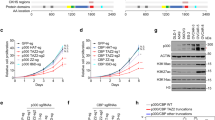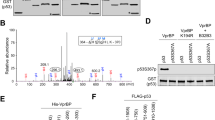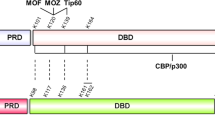Abstract
The transcriptional activity of the tumour suppressor, p53, requires direct binding between its transactivation domain (TAD, 1–57) and the transcriptional coactivator, p300. We systematically assessed the role of TAD phosphorylation on binding of the p300 domains CH3, Taz1, Kix and IBiD. Thr18 phosphorylation increased the affinity up to sevenfold for CH3 and Taz1, with smaller increases from phosphorylation of Ser20, Ser15, Ser37, Ser33, Ser46 and Thr55. Binding of Kix and IBiD was less sensitive to phosphorylation. Strikingly, hepta-phosphorylation of all Ser and Thr residues increased binding 40- and 80-fold with CH3 and Taz1, respectively, but not with Kix or IBiD. Substitution of all phospho-sites with aspartates partially mimicked the effects of hepta-phosphorylation. Mdm2, the main negative regulator of p53, competes with p300 for binding to TAD. Binding of Mdm2 to TAD was reduced significantly only on phosphorylation of Thr18 (sevenfold) or by hepta-phosphorylation (24-fold). The relative affinities of Mdm2 and p300 for p53 TAD can thus be changed by up to three orders of magnitude by phosphorylation. Accordingly, phosphorylation of Thr18 and hepta-phosphorylation dramatically shifts the balance towards favouring the binding of p300 with p53, and is thus likely to be an important factor in its regulation.
This is a preview of subscription content, access via your institution
Access options
Subscribe to this journal
Receive 50 print issues and online access
$259.00 per year
only $5.18 per issue
Buy this article
- Purchase on Springer Link
- Instant access to full article PDF
Prices may be subject to local taxes which are calculated during checkout





Similar content being viewed by others
Abbreviations
- CH1/CH3:
-
cysteine-histidine-rich regions 1 and 3
- TAD:
-
p53 transactivation domain
References
Ashcroft M, Kubbutat MH, Vousden KH . (1999). Regulation of p53 function and stability by phosphorylation. Mol Cell Biol 19: 1751–1758.
Bean LJ, Stark GR . (2002). Regulation of the accumulation and function of p53 by phosphorylation of two residues within the domain that binds to Mdm2. J Biol Chem 277: 1864–1871.
Blattner C, Tobiasch E, Litfen M, Rahmsdorf HJ, Herrlich P . (1999). DNA damage induced p53 stabilization: no indication for an involvement of p53 phosphorylation. Oncogene 18: 1723–1732.
Bottger V, Bottger A, Garcia-Echeverria C, Ramos YF, van der Eb AJ, Jochemsen AG et al. (1999). Comparative study of the p53-mdm2 and p53-MDMX interfaces. Oncogene 18: 189–199.
Brown CJ, Srinivasan D, Jun LH, Coomber D, Verma CS, Lane DP . (2008). The electrostatic surface of MDM2 modulates the specificity of its interaction with phosphorylated and unphosphorylated p53 peptides. Cell Cycle 7: 608–610.
Chao C, Herr D, Chun J, Xu Y . (2006). Ser18 and 23 phosphorylation is required for p53-dependent apoptosis and tumor suppression. Embo J 25: 2615–2622.
Chi SW, Lee SH, Kim DH, Ahn MJ, Kim JS, Woo JY et al. (2005). Structural details on mdm2-p53 interaction. J Biol Chem 280: 38795–38802.
Di Lello P, Jenkins LM, Jones TN, Nguyen BD, Hara T, Yamaguchi H et al. (2006). Structure of the Tfb1/p53 complex: insights into the interaction between the p62/Tfb1 subunit of TFIIH and the activation domain of p53. Mol Cell 22: 731–740.
Dornan D, Hupp TR . (2001). Inhibition of p53-dependent transcription by BOX-I phospho-peptide mimetics that bind to p300. EMBO Rep 2: 139–144.
Dornan D, Shimizu H, Perkins ND, Hupp TR . (2003). DNA-dependent acetylation of p53 by the transcription coactivator p300. J Biol Chem 278: 13431–13441.
Johnson TM, Attardi LD . (2006). Dissecting p53 tumor suppressor function in vivo through the analysis of genetically modified mice. Cell Death Differ 13: 902–908.
Knights CD, Liu Y, Appella E, Kulesz-Martin M . (2003). Defective p53 post-translational modification required for wild type p53 inactivation in malignant epithelial cells with mdm2 gene amplification. J Biol Chem 278: 52890–52900.
Lai Z, Auger KR, Manubay CM, Copeland RA . (2000). Thermodynamics of p53 binding to hdm2(1–126): effects of phosphorylation and p53 peptide length. Arch Biochem Biophys 381: 278–284.
Lambert PF, Kashanchi F, Radonovich MF, Shiekhattar R, Brady JN . (1998). Phosphorylation of p53 serine 15 increases interaction with CBP. J Biol Chem 273: 33048–33053.
Lavin MF, Gueven N . (2006). The complexity of p53 stabilization and activation. Cell Death Differ 13: 941–950.
Legge GB, Martinez-Yamout MA, Hambly DM, Trinh T, Lee BM, Dyson HJ et al. (2004). ZZ domain of CBP: an unusual zinc finger fold in a protein interaction module. J Mol Biol 343: 1081–1093.
Lill NL, Grossman SR, Ginsberg D, DeCaprio J, Livingston DM . (1997). Binding and modulation of p53 by p300/CBP coactivators. Nature 387: 823–827.
Liu G, Xia T, Chen X . (2003). The activation domains, the proline-rich domain, and the C-terminal basic domain in p53 are necessary for acetylation of histones on the proximal p21 promoter and interaction with p300/CREB-binding protein. J Biol Chem 278: 17557–17565.
Lu H, Levine AJ . (1995). Human TAFII31 protein is a transcriptional coactivator of the p53 protein. Proc Natl Acad Sci USA 92: 5154–5158.
Marine JC, Jochemsen AG . (2004). Mdmx and Mdm2: brothers in arms? Cell Cycle 3: 900–904.
Melcher K . (2000). The strength of acidic activation domains correlates with their affinity for both transcriptional and non-transcriptional proteins. J Mol Biol 301: 1097–1112.
Oliner JD, Pietenpol JA, Thiagalingam S, Gyuris J, Kinzler KW, Vogelstein B . (1993). Oncoprotein MDM2 conceals the activation domain of tumour suppressor p53. Nature 362: 857–860.
Polley S, Guha S, Roy NS, Kar S, Sakaguchi K, Chuman Y et al. (2008). Differential recognition of phosphorylated transactivation domains of p53 by different p300 domains. J Mol Biol 376: 8–12.
Saito S, Yamaguchi H, Higashimoto Y, Chao C, Xu Y, Fornace Jr AJ et al. (2003). Phosphorylation site interdependence of human p53 post-translational modifications in response to stress. J Biol Chem 278: 37536–37544.
Sakaguchi K, Saito S, Higashimoto Y, Roy S, Anderson CW, Appella E . (2000). Damage-mediated phosphorylation of human p53 threonine 18 through a cascade mediated by a casein 1-like kinase. Effect on Mdm2 binding. J Biol Chem 275: 9278–9283.
Schon O, Friedler A, Bycroft M, Freund SM, Fersht AR . (2002). Molecular mechanism of the interaction between MDM2 and p53. J Mol Biol 323: 491–501.
Teufel DP, Freund SM, Bycroft M, Fersht AR . (2007). Four domains of p300 each bind tightly to a sequence spanning both transactivation subdomains of p53. Proc Natl Acad Sci USA 104: 7009–7014.
Teufel DP, Kao RY, Acharya KR, Shapiro R . (2003). Mutational analysis of the complex of human RNase inhibitor and human eosinophil-derived neurotoxin (RNase 2). Biochemistry 42: 1451–1459.
Thut CJ, Chen JL, Klemm R, Tjian R . (1995). p53 transcriptional activation mediated by coactivators TAFII40 and TAFII60. Science 267: 100–104.
Toledo F, Wahl GM . (2006). Regulating the p53 pathway: in vitro hypotheses, in vivo veritas. Nat Rev Cancer 6: 909–923.
Wells M, Tidow H, Rutherford TJ, Markwick P, Jensen MR, Mylonas E et al. (2008). Structure of tumor suppressor p53 and its intrinsically disordered N-terminal transactivation domain. Proc Natl Acad Sci USA 105: 5762–5767.
Xu Y . (2003). Regulation of p53 responses by post-translational modifications. Cell Death Differ 10: 400–403.
Zor T, Mayr BM, Dyson HJ, Montminy MR, Wright PE . (2002). Roles of phosphorylation and helix propensity in the binding of the KIX domain of CREB-binding protein by constitutive (c-Myb) and inducible (CREB) activators. J Biol Chem 277: 42241–42248.
Acknowledgements
We thank Drs Jenifer Lum and Hadassah Sade for helpful suggestions and critical reading of the paper.
Author information
Authors and Affiliations
Corresponding author
Rights and permissions
About this article
Cite this article
Teufel, D., Bycroft, M. & Fersht, A. Regulation by phosphorylation of the relative affinities of the N-terminal transactivation domains of p53 for p300 domains and Mdm2. Oncogene 28, 2112–2118 (2009). https://doi.org/10.1038/onc.2009.71
Received:
Revised:
Accepted:
Published:
Issue Date:
DOI: https://doi.org/10.1038/onc.2009.71
Keywords
This article is cited by
-
Unmasking the biological function and regulatory mechanism of NOC2L: a novel inhibitor of histone acetyltransferase
Journal of Translational Medicine (2023)
-
VprBP/DCAF1 regulates p53 function and stability through site-specific phosphorylation
Oncogene (2023)
-
Programmed cell death 11 modulates but not entirely relies on p53-HDM2 loop to facilitate G2/M transition in colorectal cancer cells
Oncogenesis (2023)
-
Deciphering the acetylation code of p53 in transcription regulation and tumor suppression
Oncogene (2022)
-
Ribosomal L1 domain-containing protein 1 coordinates with HDM2 to negatively regulate p53 in human colorectal Cancer cells
Journal of Experimental & Clinical Cancer Research (2021)



